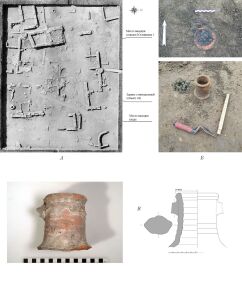 Mikhail G. Abramzona, #, Sergey N. Ostapenkob, ##
Mikhail G. Abramzona, #, Sergey N. Ostapenkob, ##
a Institute of Archaeology RAS, Moscow; Nosov Magnitogorsk State Technical University, Magnitogorsk, Russia
b “Fanagoria” State Historical and Archaeological Museum-Reserve, Sennoy, Krasnodar Territory, Russia
#E-mail: abramzon-m@mail.ru
##E-mail: osn-23@mail.ru
Keywords: Phanagoria, early Medieval period, Byzantine Empire, Justinian I, currency, coin hoards.
The paper discusses a hoard of the Late Bosporan staters found in the sixth-century fire layer in Phanagoria. A purse with 82 coins was hidden in the neck of an Opaiţ B–1b type early medieval amphora. The hoard includes staters of Thothorses, Rhadamsades, and Rhescuporis VI, as well as a Panticapaean tetrachalkos by Asander’s time. The fire layer is associated with the report of Procopius of Caesarea (Procop. Caes. De bell. VIII. 5.28) on the destruction of Phanagoria and Cepoi. The date of the disaster in Phanagoria and the concealment of the coin hoard is determined by the two main circumstances. The first one is the discovery of Justinian Ι’s solidus of 545–565 Group together with Late Bosporan staters in a nearby building which met its end in the same fire. The second circumstance is the date of Procopius’ completing Book VIII of his History of Wars, i.e., 554. Thus, Phanagoria and Cepoi were not destroyed before 545, nor it happened after 554. Accordingly, the hoard’s deposition dates back to 545‒554.
DOI: 10.31857/S0869606322010214







